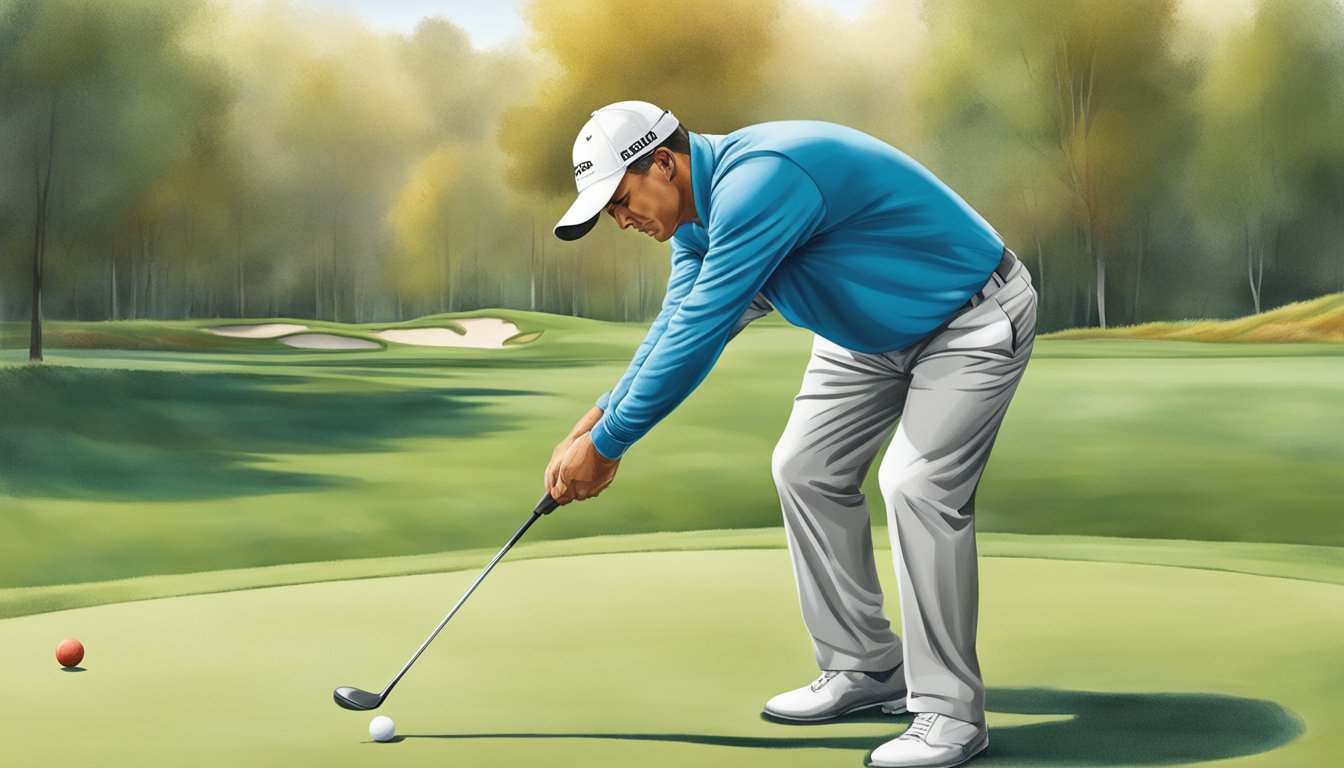Are you tired of shanking your irons on the golf course? It can be frustrating to have a great setup and swing, only to hit the ball off the hosel and send it flying in the wrong direction. But don’t worry, you’re not alone. Shanking is a common problem that many golfers face, regardless of their skill level. In this article, we’ll explore the causes of shanking and provide tips on how to fix it.


Understanding the shank is the first step in overcoming it. A shank occurs when the ball is struck off the hosel of the club, resulting in a shot that goes off to the right (for right-handed golfers). The cause of the shank can vary, but it’s often due to a swing fault or a mental block. Once you understand what’s causing your shanks, you can take steps to correct it.
Common causes of shanking include poor posture, an incorrect swing path, and an unstable grip. Luckily, there are ways to fix these issues and start hitting your irons cleanly. By making adjustments to your setup and swing, you can eliminate the shank and start enjoying your time on the course. Keep reading to learn more about how to stop shanking your irons.
Key Takeaways
- Shanking is a common problem among golfers of all skill levels.
- Understanding the cause of the shank is the first step in overcoming it.
- Common causes of shanking include poor posture, an incorrect swing path, and an unstable grip.
Understanding the Shank
https://www.youtube.com/watch?v=yNrp6J7f98M&embed=true
If you’re a golfer, you know that there are few things more frustrating than shanking the golf ball. A shank is when the ball is struck with the hosel of the club, resulting in a shot that veers off to the right (for right-handed golfers) and often travels very little distance. It’s also sometimes called a “hosel rocket” or simply a “nightmare.”
Shanks can happen to golfers of all skill levels, from beginners to professionals, and they can happen with any club in the bag. They’re more common with irons than with woods, but they can happen with any club. Shanking the golf ball can ruin an otherwise good round, and it can be a major source of frustration for golfers.
The shank in golf is caused by the clubface striking the ball too close to the hosel, which is the part of the club where the shaft meets the clubhead. When the ball is struck with the hosel, it can cause the clubface to twist, resulting in the shot veering off to the right. It’s important to note that shanking the ball is not the same thing as hitting a slice. A slice is when the ball curves to the right (again, for right-handed golfers), but it’s still struck with the center of the clubface.
There are several reasons why golfers shank their irons. One common cause is poor alignment. If your feet, hips, and shoulders are not aligned properly, it can cause your swing path to be off, which can lead to shanking the ball. Another common cause is swinging too hard or too fast. When you swing too hard, it can cause your body to move out of position, which can lead to shanking the ball. Finally, swinging too steeply can also cause you to shank the ball. If you’re coming down too steeply on the ball, it can cause the clubface to strike the ball too close to the hosel.
Common Causes of Shanking
https://www.youtube.com/watch?v=dSAEUZLwvzg&embed=true
Shanking is a frustrating problem that can plague even the most experienced golfers. There are several potential causes of shanking, and identifying the root of the problem is the first step toward correcting it. Here are some of the most common causes of shanking:
Faulty Grip and Stance
One of the most common causes of shanking is an improper grip and stance. If your grip is too tight or too loose, or if your stance is too narrow or too wide, you may be more likely to shank the ball. To correct this, make sure that your grip is firm but not too tight, and that your stance is comfortable and balanced.
Incorrect Swing Path and Plane
Another common cause of shanking is an incorrect swing path and plane. If you are swinging outside to inside or over the top, you may be more likely to shank the ball. To correct this, focus on keeping your swing path on a straight line toward the target and keeping your swing plane on the same plane as the ball.
Improper Ball Position and Weight Distribution
Finally, improper ball position and weight distribution can also contribute to shanking. If you are leaning too far forward or swaying during your swing, you may be more likely to hit the ball with the heel of the club and shank it. To correct this, make sure that your weight is evenly distributed and that you are not swaying or sliding during your swing. Additionally, make sure that the ball is positioned correctly in relation to your stance and clubhead.
By addressing these common causes of shanking, you can start to improve your iron shots and reduce the number of shanks in your game. Remember to focus on your grip, stance, swing path, and weight distribution, and don’t be afraid to seek out additional resources and instruction if you continue to struggle with shanking.
How to Stop Shanking Your Irons
https://www.youtube.com/watch?v=i_05rT9d1E0&embed=true
Shanking your irons can be frustrating, but it’s a problem that can be fixed with the right drills and exercises. Here are a few tips to help you stop shanking your irons and start hitting more accurate shots.
Effective Drills and Exercises
One of the best ways to fix shanking is to practice drills that help you develop a better swing technique. One such drill is the “toe up” drill. Start by taking your normal stance and then lift your toes up so that only your heels are on the ground. Swing the club back and forth, trying to keep your toes up throughout the swing. This drill will help you stay more centered during your swing and prevent you from lunging or sliding through the ball.
Another great exercise is to practice hitting shots with your eyes closed. This will help you develop a better feel for where the clubhead is in relation to the ball and the sweet spot. Start by hitting short chip shots with your eyes closed and gradually work your way up to longer shots.
Proper Setup and Alignment
Having the correct setup and alignment is crucial to hitting accurate shots. Make sure your ball-to-target line is correct and that you are aiming at your target. Line up your feet, hips, and shoulders parallel to the ball-to-target line. This will help you hit more accurate shots and prevent you from hitting the ball off the hosel.

Correct Grip and Grip Pressure
The way you grip the club can also have a big impact on your swing and accuracy. Make sure you have a relaxed grip, with your hands and fingers wrapped around the club in a natural way. Your grip pressure should be firm but not too tight. If your grip is too tight, it can cause tension in your arms and prevent you from making a smooth, fluid swing.
By following these tips and practicing the right drills and exercises, you can cure your shanks and start hitting more accurate shots with your irons. Remember to stay patient and keep working on your swing and technique. With time and practice, you’ll be hitting the ball with precision and power in no time.
Mental Approach to Overcoming Shanks

Sometimes, shanking your irons can be caused by a mental block. It’s important to approach the situation with a calm and positive attitude. Remember, golf is a game and it’s meant to be enjoyed. Don’t let a few bad shots ruin your day.
One mental approach to overcoming shanks is to focus on your breathing. Take a few deep breaths before each shot to help calm your nerves. This can also help you maintain a steady tempo in your golf swing.

Another mental approach is to visualize a successful shot before you take it. Imagine the ball flying straight towards your target and landing softly on the green. This can help you feel more confident and relaxed during your swing.
It’s also important to avoid getting too caught up in the technical aspects of your golf swing. Instead, focus on swinging lightly and smoothly. This can help you avoid tensing up and shanking your shot.
Remember, golf is a mental game as much as it is a physical one. By approaching each shot with a positive and relaxed attitude, you can overcome shanks and enjoy your time on the golf course.
Conclusion

Shanking your irons can be frustrating, but it’s a common problem that many golfers face. By understanding the causes of shanking, you can take steps to fix your swing and improve your accuracy.

One of the most common causes of shanking is poor posture. If you’re standing too close or too far away from the ball, you’re more likely to shank your shot. Make sure you’re standing the correct distance from the ball and that your posture is correct.
Another cause of shanking is lunging or sliding during your swing. This can cause you to hit the ball with the hosel of the club, resulting in a shank. To fix this, focus on maintaining your balance and keeping your weight evenly distributed throughout your swing.
It’s also important to remember that shanking can be caused by a variety of factors, including grip, swing plane, and ball position. If you’re struggling with shanking, consider working with a golf pro to identify the root cause of the problem and develop a plan to fix it.
Improving your accuracy on the golf course takes time and practice, but by focusing on the basics of your swing and addressing any issues that may be causing you to shank your irons, you can improve your ball flight and become a more consistent player.
Frequently Asked Questions
https://www.youtube.com/watch?v=SRVWhGQRmM8&embed=true
What are some drills to fix shanking irons?
There are many drills that can help you fix shanking irons. One such drill is to place a tee about an inch outside of the ball and try to hit the ball without hitting the tee. Another drill is to place a towel under your arms and try to hit the ball without letting the towel fall out. Additionally, practicing hitting the ball with your weight on the front foot can also help.
How can a weak grip cause shanks?
A weak grip can cause shanks because it can cause the clubface to be open at impact, which can result in the ball being hit off the hosel of the club. This can cause the ball to go sharply to the right for a right-handed golfer.
What is the difference between shanking short irons and long irons?
The difference between shanking short irons and long irons is that with short irons, the ball is closer to you, and the clubface is more upright. With long irons, the ball is farther away, and the clubface is flatter. This can cause the swing to be more flat, which can lead to shanking the ball.
Are there any anti-shank irons available?
There are no anti-shank irons available. However, there are some irons that are designed to be more forgiving, which can help reduce the chances of shanking the ball.
What are some simple cures for the shanks?
Some simple cures for the shanks include making sure your weight is on the front foot, keeping your arms extended, and making sure you are not standing too close to the ball. Additionally, focusing on hitting the ball with the center of the clubface can also help.

How can I mentally get over shanking my irons?
To mentally get over shanking your irons, it is important to stay positive and not get too frustrated. Visualizing yourself hitting good shots can also help. Additionally, focusing on your breathing and taking deep breaths can help calm your nerves and reduce anxiety.










